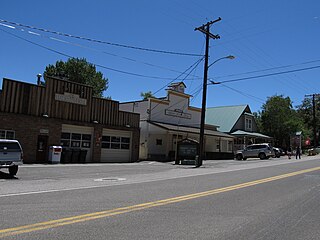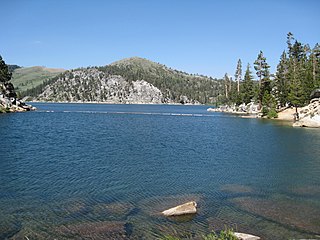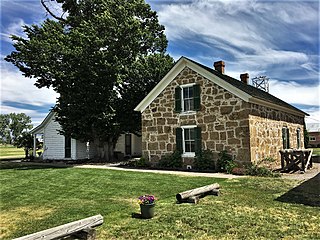
Minden is a census-designated place (CDP) in Douglas County, Nevada, United States. The population was 3,001 at the 2010 census. It is the county seat of Douglas County and is adjacent to the town of Gardnerville. It was founded in 1906 by Heinrich Friedrich Dangberg Jr., who named it after the town of Minden, in the German state of North Rhine-Westphalia, which was near his father's birthplace. A large share of the first settlers were Germans. Minden was founded on company land of the Dangberg Home Ranch and Dangberg commissioned most of the town's early buildings. Minden has had a post office since 1906.

Genoa is an unincorporated town in Douglas County, Nevada, United States. Founded in 1851, it was the first settlement in what became the Nevada Territory. It is situated within Carson River Valley and is approximately 42 miles (68 km) south of Reno at 39.005,-119.846. The population was 939 at the 2010 census. It is home to the oldest bar in the state of Nevada which opened in 1853.
Frederic Joseph DeLongchamps was an American architect. He was one of Nevada's most prolific architects, yet is notable for entering the architectural profession with no extensive formal training. He has also been known as Frederick J. DeLongchamps, and was described by the latter name in an extensive review of the historic importance of his works which led to many of them being listed on the U.S. National Register of Historic Places in the 1980s.

The Marlette Lake Water System was created to provide water for the silver mining boom in Virginia City, Nevada. These structures are now listed as a National Historic Civil Engineering Landmark by the American Society of Civil Engineers, and are also listed on the National Register of Historic Places. The listed area included two contributing buildings and 12 contributing structures on 135.4 acres (54.8 ha). It has also been known historically as the Virginia and Gold Hill Water Company Water System.

Douglas County High School was the high school serving Douglas County, Nevada from 1915 to the mid-1950s when it became a middle school. In 1988, the building was retired from educational uses. Designed by prolific Nevada architect Frederic Joseph DeLongchamps, it serves today as both the Carson Valley Museum & Cultural Center and a middle school and is listed on the United States National Register of Historic Places.

The Dangberg Home Ranch Historic Park is a Douglas County, Nevada, USA, park, preserving one of the state's first ranches.

The Sears–Ferris House, at 311 W. Third St. in Carson City, Nevada, is a historic house built in 1863. It was owned from 1868 to 1890 by George Washington Gale Ferris Sr., father of George Washington Gale Ferris Jr., future inventor of the Ferris wheel. It has also been known as the G. W. G. Ferris House.

Farmer's Bank of Carson Valley is a historic bank building located at 1596 Esmeralda Avenue in Minden, Nevada. The building was built in 1909 to house the Farmer's Bank of Carson Valley, which was chartered in the same year. H. F. Dangberg, the founder of Minden, commissioned the building, which was only the second building built in the town. In 1918, the bank outgrew its original building and moved to a larger building across the street. After the bank left the building, it was occupied by the Minden Post Office until 1974. The building has housed a variety of businesses since and is currently occupied by the Bank Parlor and Pub.

Farmer's Bank of Carson Valley is a historic bank building located at 1597 Esmeralda Avenue in Minden, Nevada. The bank was built from 1916 to 1918 to replace the original 1909 bank building, which the Farmer's Bank had outgrown. Prominent Nevada architect Frederic Joseph DeLongchamps designed the building in the Classical Revival style; the bank is one of many Neoclassical structures designed by DeLongchamps in Minden. The bank's design features a cornice with terra cotta tiles and bands, a flat roof with a low parapet, and an entrance portico with Ionic columns. The bank was built for Farmer's Bank organizer H. F. Dangberg, who was also the founder of Minden. The building served as a bank until 1968 and currently houses offices.

The Carson Valley Improvement Club Hall is a historic building located at 1606 Esmeralda Avenue in Minden, Nevada. The building was constructed in 1912 as a meeting hall for the Carson Valley Improvement Club. The two-story building features a variety of brickwork patterns but has an otherwise plain design. The Carson Valley Improvement Club used the building to host both community social events and town meetings. The building has served as the informal seat of government in Minden since its construction; after the Carson Valley Improvement Club moved out in 1920, the Minden Commercial Club and later the Minden Town Board continued to hold government meetings at the building. Though Minden is unincorporated, the groups meeting in this building have acted as local liaisons to Douglas County's government and have helped manage local government services. In addition, the building has continued to house a variety of social events, including concerts, movies, religious services, and basketball games.

The Minden Wool Warehouse is a historic warehouse building located at 1615 Railroad Avenue in Minden, Nevada. Built in 1915, the warehouse was designed by prominent Nevada architect Frederic Joseph DeLongchamps. DeLongchamps designed the building for H. F. Dangberg, the founder of Minden, and the warehouse served as the headquarters for Dangberg's Dangberg Land and Livestock Company. Carson Valley farmers used the warehouse to store wool and potatoes before they were shipped out of Minden. The warehouse was later rented to the Minden Flour Company and a local creamery; it is now used as an office building by the Bently Nevada Corporation.
George A. Ferris & Son was an architectural firm in Reno, Nevada, consisting of partners George Ashmead Ferris (1859-1948) and his son Lehman "Monk" Ferris (1893-1996). The partnership lasted from just 1928 to 1932; both father and son however were individually prominent.

The Wabuska Railroad Station, on S. Carson St. in Carson City, Nevada, was built in 1906. It was a work of the Southern Pacific Co.. It was listed on the National Register of Historic Places in 1984.

The Leport–Toupin House, at 503 E. Telegraph St. in Carson City, Nevada, is a historic simplified-Second Empire-style house that was built in 1879. It was converted to a pre-school in 1969. Also known as the Hawkins House, it was listed on the National Register of Historic Places in 1985.

The Arendt Jensen House, at 1431 Ezell St. in Gardnerville, Nevada, is a historic foursquare house—in this case termed a "Denver Square" form—that was built in 1910. It was a home of Danish immigrant Arendt Jensen, a merchant who became prominent in Gardnersville. Also known as the Reid Mansion, it includes Colonial Revival-style ornamentation. It was listed on the National Register of Historic Places in 1989; the listing included two contributing buildings: the second is an accompanying garage.

The Lew M. Meder House, at 308 N. Nevada St. in Carson City, Nevada, United States, is a historic house with Late Victorian architecture that was built in 1876. It was listed on the National Register of Historic Places in 1978.

The Carson Brewing Company, at 102 S. Division St. in Carson City, Nevada, was built in 1864. Also known as the Carson City Nevada Appeal Building, it was listed on the National Register of Historic Places in 1978. It was originally a brewery and bar.

The David Smaill House, at 313 W. Ann St. in Carson City, Nevada, was built in c.1876. Also known as the Smaill House, it was listed on the National Register of Historic Places in 1985.

The Carson City Public Buildings, on Carson St. in Carson City, Nevada is a set of historic buildings dating back to 1920. There are three contributing buildings. The set was listed on the National Register of Historic Places in 1987. The three are the Nevada State Supreme Court Building, the Ormsby County Courthouse, and the Heroes Memorial Building, designed by Nevada premier architect Frederick J. DeLongchamps.

The Rinckel Mansion, at 102 N. Curry St. in Carson City, Nevada, is a historic house built in 1872. It was home of Mathias Rinckel, a merchant in Carson City. It was designed and built by Ecole de Beaux Arts-trained architect Charles H. Jones.




















